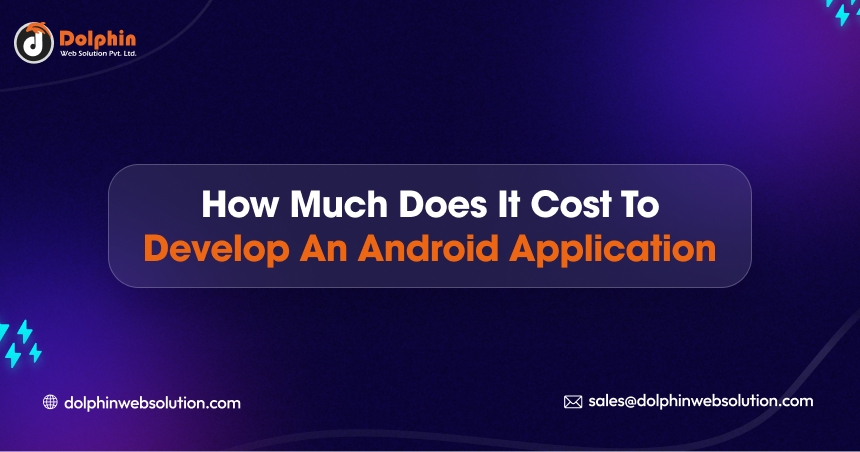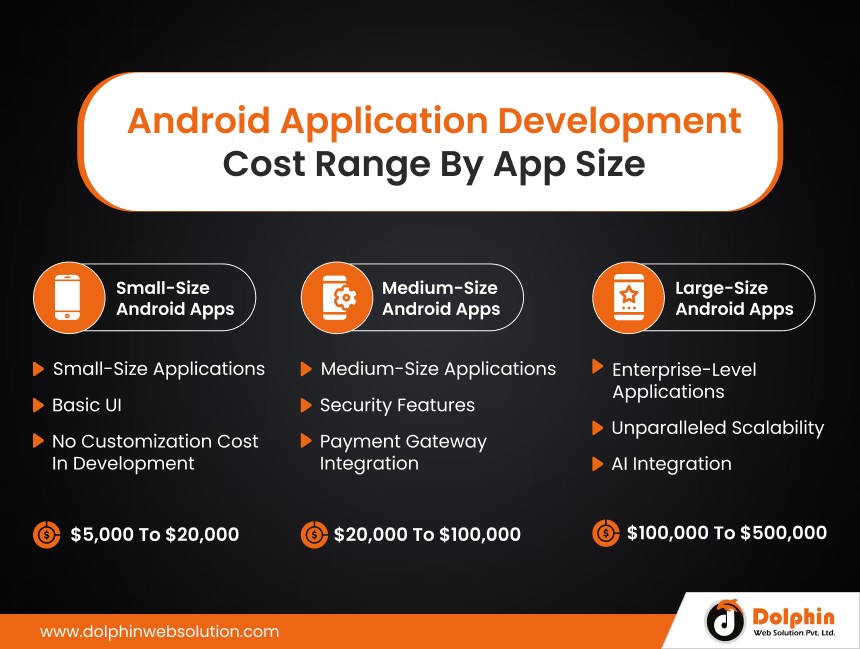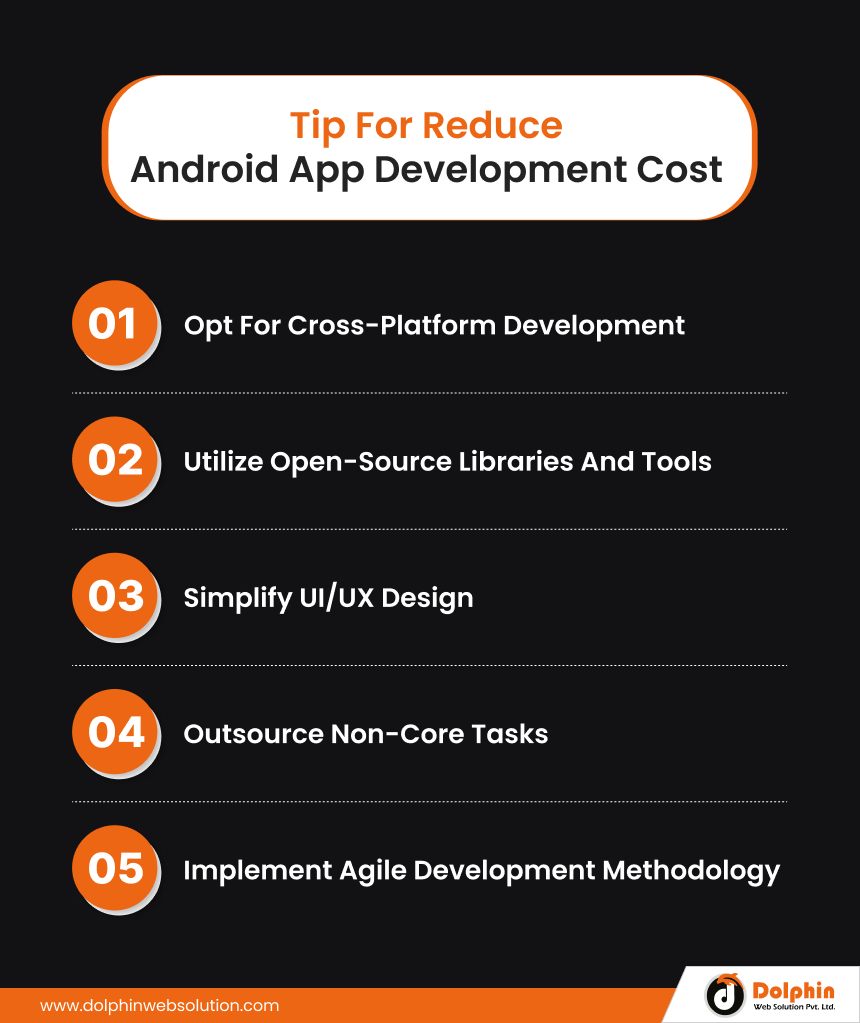How Much Does It Cost to Develop an Android Application

Table of Contents
- 1 Estimating the Cost of Android App Development
- 2 Android Application Development Cost Range by App Size
- 3 Factors Affecting Android App Development Cost
- 4 Android App Development Cost Breakdown
- 5 Cost of Hiring an Android App Developer Hiring Model
- 6 Tip for Reduce Android App Development Cost
- 7 Conclusion
Summary :
There are millions (2.59M approx.) apps on the Google Play Store and many more millions (3.3B approx.) of users having access to these apps. Entering this lucrative realm seems like an enticing prospect. Now, you might be wondering about the expenses involved in developing an Android application. The truth is, determining the exact cost is no walk in the park as it hinges on various factors such as backend deployment architecture, incorporation of third-party applications, level of customization, and complexity of features. Let's delve into each element of the cost structure to gain a clearer insight.
Android has a market share of 71.74% of the global mobile operating systems with over 96.9% of Android apps being free on the Google Play Store. The reason behind this huge popularity is simple enough – it’s the enormous potential they carry- be it a start-up or a strong established business , android apps do wonder in taking it to the next level and accelerate its goal stupendously. It is essential to have a cost estimate for Android App Development to set your budget and prioritize essential application features. Average hourly rates for Android developers often range from $20 to $100+ depending on the type of development agency hired, the complexity of the features, etc.
Let’s explore the factors that will collectively shape the budget of your Android app development project.
Estimating the Cost of Android App Development
When diving into the realm of Android app development costs, a myriad of factors come into play, influencing the overall expenses at hand. These factors have been elaborated upon below. Typically, the price tag can range from as low as $5,000 to a hefty $500,000.
Android Application Development Cost Range by App Size

The broader the scope and size of your app, the higher will be the app development cost.
- Small-size Android apps: Small-size applications with basic UI and no customization cost you around $5,000 to $20,000.
- Medium-size: Medium-size applications cost around $20,000 to $100,000 and would include features like security features, payment gateway integration, etc.
- Large-size Android App: Enterprise-level applications such as eCommerce applications with chatbots, unparalleled scalability, and AI integration would cost around $100,000 to $500,000.
Factors Affecting Android App Development Cost

App Complexity
For a simple app sporting basic features like API blending, mingling with social media realms, and cozying up with databases, you could be looking at a bill ranging from $20,000 to $50,000. These apps tend to embrace the BaaS deployment model and come equipped with a pre-assembled backend structure.
Now, moving on to apps that fall into the realm of medium complexity – think custom UI elements or fancy features like basic secure payment gateways so price will be between $50,000 and $150,000. As for those intricate apps laden with complexities galore – you can expect costs stretching from $150,000 all the way up to $300,000 due to their sophisticated integration of geolocations, sensor usage, offline content browsing capabilities…and so much more!
Platform (Native vs. Cross-Platform)
The eCommerce platform you use to develop your Android application would impact the overall cost. The native platform would cost around $30,000 to $100,000 and ensure higher app security and scalability of your app. Cross-platform apps cost around $20,000 to $80,000 by facilitating the reusability of codes, which helps in reducing the cost.
Design and UI/UX
User experience and User Interface play a huge role in the success of an Android app. A well-designed app will improve user satisfaction and ensure higher user engagement. The complexity of your app design requirements will impact the development costs such as:
- Custom graphics
- Interactive elements
- Well-placed CTAs
- Animations
When it comes to infusing a tailored UX/UI design that truly resonates with your brand essence, you’re looking at an investment ranging from $10,000 to $30,000. Now, if you’re aiming for that application with interactive features like personalized illustrations and cutting-edge animations, well then be prepared to shell out an additional $30,000 to $50,000. It’s all about finding that sweet spot where design meets functionality and brand allure!
App Features
The level of complexity of the app decides the cost of developing them to a great extent. The more functionality that needs to be integrated, the more the cost increases. Some of the features that lead to enhanced price are as follows,
- Aids Real-time data synchronization, and push notifications.
- Make way for Augmented reality, advanced data processing.
- Display information, and basic user interactions.
Development Team
The cost of hiring a development team would depend on the app developer’s model. If you want more flexibility and cost-efficiency when hiring developers, you can opt for freelancers. In-house developers and Android app development companies would cost you more, but they would bring more accountability and the latest app development resources.
App Maintenance and Updates
If you think developing an Android app is a one-time investment, you are wrong. It would help if you opted for continuous updates and maintenance services to keep the apps’ functionality relevant, secure, and compatible with emerging technologies.
It can cost 15% to 20% of your initial Android app development cost for ongoing maintenance per year.
Here is a breakdown of the overall app maintenance and update costs:
- Compatibility updates for aligning the app to the latest operating systems
- Bug fixes and enhancing the features: $2,000 to $10,000 per year
- Ongoing maintenance of the app
Third-party integrations and APIs
API is implemented to facilitate specific or custom services in the application. API enables two apps to connect and facilitate data exchanges between apps. You can integrate social media platforms using APIs, authenticate financial transactions, run affiliate ads, etc. Some of the most popular APIs include Google Ads, PayPal API, Google Maps, etc. The cost of third-party integrations and APIs can cost $1000 to $10,000 or even more.
App Testing and Quality Assurance
Without rigorous testing, you won’t be able to ensure the security, performance, and functionality of the Android app. Both automated and manual testing efforts would contribute to the development costs. It can cost around $5,000 to $15,000 for Quality Assurance testing depending on the size of the app and its complexities.
App Deployment and Distribution
Google Play Store charges a one-time fee of $25 to launch an Android app on their platform. Your developer may also charge depending on the complexities involved with the app distribution and deployment on the Play Store.
Android App Development Cost Breakdown
1. Development Hours Breakdown
Timelines of project completion will depend on various factors like the expertise of the development team, the size
of the Android app, the complexity of the features, etc.
| Type of the App | Estimated Time |
|---|---|
| Simple Android App Development | 2 to 4 months |
| Average Android App Development | 4 to 6 months |
| Complex Android App Development | 9+ months |
Let us understand the various development tasks, such as frontend and backend development, and their associated costs:
Backend Development
The backend is responsible for providing security and storing data. It serves the same function as your server and can be accessed via the internet through API. You can hire an in-house app for backend development or use backend storage services provided by third-party companies. It can cost around $8,000 to $30,000 for backend development.
Frontend Development
The frontend development is what is visible to the users. From the design of the app to the structure, content layout, app behavior, and navigation is developed by frontend developers.
Design Costs
The design process starts with outlining the strategy to convert your notion to a fully functioning, robust Android app. They will create wireframes to understand the conceptual layouts better and create a visual structure for the functional needs of your app.
They will focus on the user experience and aesthetics of your app, which would cost around $2000 to $10,000.
The UX design of your app would cost around $3,000 – $12,000. Next, they would perform the mockups by applying the style guide in your app wireframes.
Developers would then convert the static mockup into prototypes using advanced tools such as Invasion and Figma. Prototyping facilitates app workflow and user experience. It would cost an additional $1000 to $5000 for prototyping.
2. Features and Functionality
Android apps with simple features are easier to develop as there are fewer coding requirements and few third-party
integrations.
| Features | Costs |
|---|---|
| User authentication | $2,000 – $8,000 |
| Push notifications and Real-time Data Synchronization | $5,000 – $20,000 |
| Payment Integration | $3,000 – $15,000 |
| Augmented reality and advanced data processing | $50,000+ |
3. Testing and Quality Assurance
To make your app accessible to your users and compatible with the latest upgrades of the Google Play Store, testing and quality assurance services are essential. Bug fixes and technical glitches on the app before launching it on the Play Store will create the best impression at first on your users.
Manual Testing
If you are using an Agile testing framework, manual testing holds equal importance as automated testing.
Automated Testing
After detecting the patterns of outcome using manual testing, developers would proceed with predictable tests and automated routine tests.
| Types of Testing | Costs |
|---|---|
| Manual Testing | $3,000 -$10,000 |
| Automated Testing | $5,000 – $15,000 |
| Device Testing | $2,000 – $8,000 |
4. Additional Costs
Besides the above-mentioned main app development costs, there are multiple miscellaneous costs involved, which are presented in the table below:
| Miscellaneous Cost Heads | Expenses |
|---|---|
| App Store Submission | $25 – $100 |
| Third-Party Integrations | $2,000 – $10,000 |
| Backend Infrastructure | $5,000 – $20,000 |
| Marketing | $10,000+ |
| Licensing | $25 to $400 per month |
Cost of Hiring an Android App Developer Hiring Model
The right developer model would not only influence the financial landscape of your app development project but also impact its relevance and success.
Freelance Android App Developer
Freelance Android app developers are independent professionals who work remotely on your projects. It can cost around $20 to $100 per hour to hire freelancers for your project.
Freelance Android App Developer Pros:
- Freelance Android app developers offer flexibility in terms of cost and availability.
- They are budget-friendly options as compared to in-house developers and other developer models.
- They have specialized talents and bring diverse skill sets to scale your application rapidly. They have expertise in various industry domains and technologies.
Freelance Android App Developer Cons:
- Lack of accountability in terms of completion of the project or meeting project requirements is a concern when hiring freelance Android app developers.
- They charge hidden costs after the project, which can increase your overall expenses.
In-House Android App Developer
If you want a dedicated team of developers to work within your organization for Android app development, then opt for in-house Android app developers. They will work exclusively on your project and execute a high level of control and collaboration with the organization.
In-House Android App Developer Pros:
- It allows immediate oversight and direct control by the organization. Businesses can make real-time adjustments to the development process and align the project with their organizational goals.
- It creates a collaborative environment and streamlines communication, which fosters project efficiency.
In-House Android App Developer Cons:
- It would result in higher infrastructure expenses and salaries for the in-house developers.
- In-house developers may have limited skills in comparison to specialized app development agencies.
Outsourced Android App Development
Hiring external app development companies to handle the design, development, and ongoing maintenance of apps comes with its own set of pros and cons.
Outsourced Android App Development Pros:
- It is cost-efficient owing to lower labor costs, reduced overheads, and zero investment in software development stacks.
- You will get access to a large pool of experienced and qualified developers. They will be able to handle complex app development projects with ease and meet your expectations.
- They have access to the latest technologies, which can foster your app development process.
Outsourced Android App Development Cons:
- You may face cultural differences and language barriers if you hire them from any country or state.
- There will be gaps in communication as you won’t have face-to-face communication with them.
Tip for Reduce Android App Development Cost
If you are worried about the high Android app development costs, then here are some tips to reduce them:

1. Opt for Cross-Platform Development
If you are an SMB or a startup, native app development would be costly for you. When you develop an app for only one platform, you miss out on a huge chunk of the active app user base, as your target audience is platform-independent and diversified. With cross-platform development, you will get the following benefits:
- Budget-friendly and less expensive
- Explore a wider audience base
- Single code for several platforms
2. Utilize Open-Source Libraries and Tools
Leveraging open-source tools and libraries would save you from the risk of vendor lock-in, meaning not being able to change to another vendor owing to high costs.
3. Simplify UI/UX Design
Simplify the UI/UX design by integrating simple interactive elements and visual components without compromising the user experience to reduce your app development costs.
4. Outsource Non-Core Tasks
By outsourcing non-core tasks of the app development process, your in-house development team can focus on core development activities. Outsourcing enables you to tap into the experience and skilled resources of the developers at a fraction of the cost.
5. Implement Agile Development Methodology
Taking up an Agile development methodology for your app development enables continuous improvement and iterative development. Rather than attempting to develop the entire Android app at once, Agile methodology facilitates breaking the app development process into manageable, smaller sprints. This strategy helps you to:
- Release working versions of the Android app more frequently
- Make essential adjustments
- Gather feedback
- Reduce rework to save development costs.
Conclusion
Android mobile app development is an initiative that comes with a host of benefits, and the key to unlocking them is all about knowing the correct way to exploit them. Once you know that, you can manage everything from kick-off to successful delivery. If you want to tailor every aspect related to the applications, customize your apps the way you want them to be and make them uniquely yours, then deciding on the actual cost is the primary element you must keep in mind. Hope the article has enough input to help you with that. Now, you can happily enjoy the exceptional advantages of Android apps coupled with affordable prices. Alternatively, you can always get in touch with our experts to have a quote and hire an Android developer for your next project.


